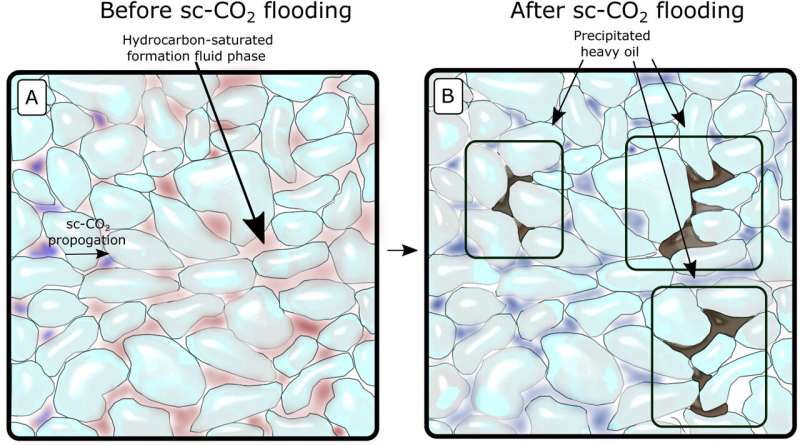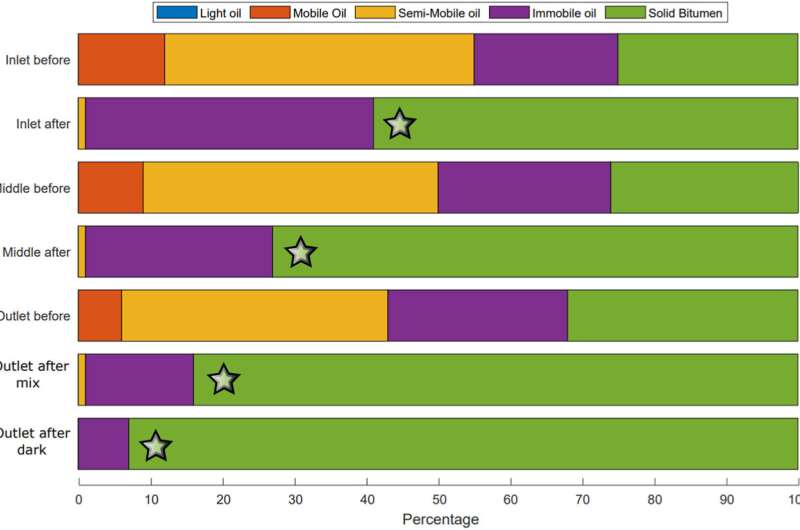August 8, 2023 feature
This article has been reviewed according to Science X's editorial process and policies. Editors have highlighted the following attributes while ensuring the content's credibility:
fact-checked
trusted source
proofread
Carbon Capture and Storage projects in Denmark at risk from bitumen formation

Carbon Capture and Storage (CCS) is increasingly being cited to help our global warming crisis by reducing greenhouse gas emissions through capturing carbon dioxide and storing deep underground. In the Danish North Sea, chalk rocks below the sea bed hold depleted oil and gas reserves and are now being considered for storing carbon dioxide to capitalize upon the pre-established infrastructure from the fossil fuel industry.
However, new research published in Marine and Petroleum Geology has considered the potential issues arising from interaction of the stored carbon dioxide with oil and gas (hydrocarbon) residues left in the rock, which can be up to 30% in chalk and 60% in sandstones.
Rasmus Stenshøj from Aarhus University, Denmark, and colleagues at the Energy & Environmental Research Center, U.S., conducted an experiment on a chalk sample of a few centimeters dating to the Upper Cretaceous (66 to ~100 million years ago) from the Halfdan Field of the North Sea.
The researchers recreated the environmental conditions of the rock from the seabed before injecting supercritical carbon dioxide (when it has properties of both a gas and liquid above a certain temperature and pressure) into the rock over a period of nine days. They then used a series of chemical and physical techniques to analyze the hydrocarbons present in rock samples taken before and after supercritical carbon dioxide injection.
Based upon temperature, different forms of hydrocarbons are present: light oil at 0–100°C, mobile oil at 100–200°C, semi-mobile oil at 200–300°C, immobile oil at 300–375°C and bitumen at 375–650°C.
Initial results revealed that the supercritical carbon dioxide caused lighter hydrocarbons to move through the rock, while heavier forms, such as bitumen and asphaltene-rich immobile oil, were left behind. This can cause blockages in the mobilization of the carbon dioxide through the rock and hamper the efficiency of the Carbon Capture and Storage system.
Importantly, the researchers found that the change in pressure at the exit point of the system resulted in more of the bitumen and other heavy hydrocarbon deposits, comprising up to 10.5% of the total rock volume here, whereas before the experiment this was just 4.17%. There is overall a distinct trend in increasing heavy hydrocarbon deposition through the system up to the exit point, thought to result from absorption of hydrocarbons by the supercritical carbon dioxide changing its solubility. Stenshøj and collaborators term this increasing bitumen from inlet to outlet the Avalanche Effect.

Immobile hydrocarbon and bitumen percentages around the inlet before and after injection are somewhat similar, which the researchers state as evidence of the supercritical carbon dioxide mobilizing through the crude oil phase to extract lighter hydrocarbons for removal through the system, leaving behind the heavier bitumen. It is suggested that this results from a direct pushing force of oil from the carbon dioxide, rather than a splitting force.
Analyzing the samples under a microscope prior to injection revealed the pores in the rock contained a mixture of water and oil, but following supercritical carbon dioxide mobilization of oil, the latter was distributed throughout the rock pores replacing water, and even accumulating in the microscopic shells of the ancient fossils of organisms known as foraminifera. This occurs as the oil is drawn into the water-dominated pores by capillary forces, hence the sample became more oil saturated, which led to a change of color to darker brown.
The solubility of hydrocarbons in response to supercritical carbon dioxide is a complex process, which can be affected by changes in temperature, pressure, hydrocarbon content and clays. Clearly the accumulation of heavier hydrocarbons at exit points can lead to plugging of the Carbon Capture and Storage system, impacting its efficiency. With enhanced research into the siting of these storage systems based upon hydrocarbon content, the possibility of making a real difference to global warming remains a tantalizing one.
More information: Rasmus Stenshøj et al, Hydrocarbon residue in a Danish chalk reservoir and its effects on CO2 injectivity, Marine and Petroleum Geology (2023). DOI: 10.1016/j.marpetgeo.2023.106424
© 2023 Science X Network





















